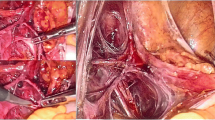Abstract
Introduction and hypothesis
Urinary retention after radical laparoscopic surgery for severe endometriosis is a clinically relevant complication. We hypothesized a relationship between the amount of resected nerves and the occurrence of urinary retention.
Methods
We evaluated, retrospectively, a cohort of 221 patients. The expression of nerves in the resected specimens was investigated in patients with urinary retention and matched controls using standardized immunohistochemistry techniques.
Results
The prevalence of urinary retention was 4.6% (n = 10). Importantly, there was no difference between cases and controls regarding the quantity of nerves in the resected specimens. The cumulative probability of 50% to overcome urinary retention was reached after 5.6 months. Age was the main risk factor for persistent retention (40.3 years with vs. 31.6 years without, p = 0.01).
Conclusions
In older endometriosis patients, surgical radicality should be balanced against preservation of organ function. There is a fairly good chance to recover, even after 6 months, which is important for patient counseling.




Similar content being viewed by others

References
Marpeau O, Thomassin I, Barranger E et al (2004) Laparoscopic colorectal resection for endometriosis: preliminary results. J Gynecol Obstet Biol Reprod (Paris) 33(7):600–606
Volpi E, Ferrero A, Sismondi P (2004) Laparoscopic identification of pelvic nerves in patients with deep infiltrating endometriosis. Surg Endosc 18:1109–1112
Donnez J, Squifflet J (2010) Complications, pregnancy and recurrence in a prospective series of 500 patients operated on by the shaving technique for deep rectovaginal endometriotic nodules. Hum Reprod 25(8):1949–1958
Campagnacci R, Perretta S, Guerrieri M et al (2005) Laparoscopic colorectal resection for endometriosis. Surg Endosc 19(5):662–664
Dubernard G, Rouzier R, David-Montefiore E, Bazot M, Daraï E (2008) Urinary complications after surgery for posterior deep infiltrating endometriosis are related to the extent of dissection and to uterosacral ligaments resection. J Minim Invasive Gynecol 15(2):235–240
Nassif J, Trompoukis P, Barata S et al (2011) Management of deep endometriosis. RBM. doi:10.1016/j.rbmo:2010:08:012
Hockel M, Konerding MA, Heussel CP (1998) Liposuction-assisted nerve sparing extended radical hysterectomy: oncologic rationale, surgical anatomy and feasibility study. Am J Obstet Gynecol 178:971–976
Querleu D, Narducci F, Poulard V et al (2002) Modified radical vaginal hysterectomy with or without laparoscopic nerve-sparing dissection: a comparative study. Gynecol Oncol 85:154–158
Possover M, Schneider A (2002) Slow-transit constipation after radical hysterectomy type III. Surg Endosc 16:847–850
Possover M, Stober S, Plaul K, Schneider A (2000) Identification and preservation of the motoric innervation of the bladder in radical hysterectomy type III. Gynecol Oncol 79:154–157
Kovoor E, Nassif J, Miranda-Mendoza I, Lang-Avérous G, Wattiez A (2010) Long-term urinary retention after laparoscopic surgery for deep endometriosis. Fertil Steril 95(2):803e9
Van Langendonckt A, Punyadeera C, Kamps R et al (2007) Identification of novel antigens in blood vessels in rectovaginal endometriosis. Mol Hum Reprod 13(12):875–886
Minelli L, Fanfani F, Fagotti A et al (2009) Laparoscopic colorectal resection for bowel endometriosis; feasibility, complications, and clinical outcome. Arch Surg 144:234–239
Acknowledgments
We thank Dr. Eberst (Hautepierre Hospital, Strasbourg, France) for his support with the urodynamic investigation.
Conflicts of interest
None.
Author information
Authors and Affiliations
Corresponding author
Rights and permissions
About this article
Cite this article
Gabriel, B., Nassif, J., Trompoukis, P. et al. Prevalence and outcome of urinary retention after laparoscopic surgery for severe endometriosis—does histology provide answers?. Int Urogynecol J 23, 111–116 (2012). https://doi.org/10.1007/s00192-011-1492-2
Received:
Accepted:
Published:
Issue Date:
DOI: https://doi.org/10.1007/s00192-011-1492-2



